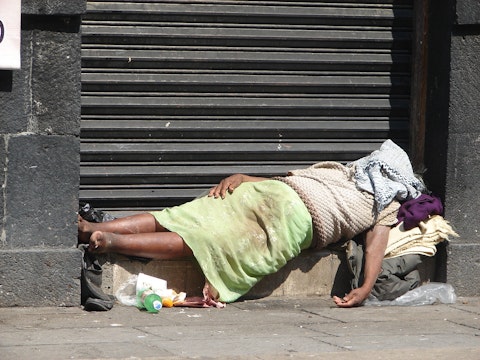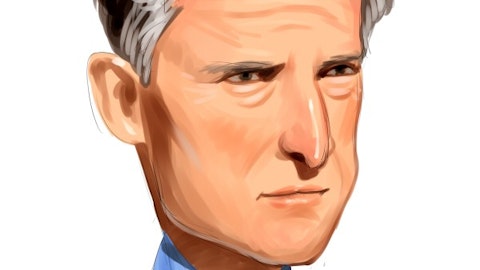In this article, we look at the 25 poorest states in America. To skip our detailed analysis on poverty and educational attainment in the U.S., you can head over directly to the 10 Poorest States in America.
Nearly 38 million people live below the poverty line in the United States, making up for 11.6% of the population. Slices of wealthy groups exist alongside pockets of poverty-stricken populations, reflecting the glaring inequality across the country. Native Americans, African Americans, and Hispanics are the most affected communities.
In terms of poverty, Mississippi is the poorest state in America with a poverty rate of 18.1% in 2021, according to the U.S. Census Bureau – followed by Louisiana at second, and New Mexico at third. On the other hand, New Hampshire has only 5.6% of its population living below the poverty line. It tops the charts of states with the lowest poverty rates in America. You can read more about states with low poverty rates in the U.S. in our article, 25 States with the Lowest Poverty Rates in America.
The disparity in economic prosperity between states could be attributed to a number of factors, including geographic locations, economic policies of the local governments, and access to resources. In our analysis, we have also observed a relationship between poverty and education levels in states. Most of the states (21) that are part of the 25 least educated states are also present in the list of the 25 poorest states ranked by poverty rates.
In terms of education, West Virginia is the least educated state in the US. Only 36% of the population aged between 18 and 24 has a college or associate degree, while a mere 14.2% of the population aged 25 and above holds a bachelor’s or undergraduate degree. New Mexico and Nevada are second and third, respectively.
A number of corporations have begun playing an active role to promote economic activity in states affected by poverty. After success in Northeast Wisconsin where 88% of schools now offer education in Computer Sciences, Microsoft Corporation (NASDAQ:MSFT), in 2022, expanded its TechSpark program to Jackson in Mississippi. The program aims to provide digital skills and access to communities that are at the risk of being left behind in the growing digital economy in the United States. As part of the initiative, Microsoft Corporation (NASDAQ:MSFT) launched a Cybersecurity Readiness Program at Jackson State University to train 100 students and provide them with practical cybersecurity experience. Microsoft Corporation (NASDAQ:MSFT)’s partnership with the state of Mississippi also includes the CoBuilder Accelerator Program, which brings together founders of 21 home-grown startups to train them and raise funding for their ventures.
In the financial markets sector, Wells Fargo & Company (NYSE:WFC) has entered into a $15 million collaboration with a nonprofit organization called ideas42, to accelerate economic activity in low and middle income regions. Wells Fargo & Company (NYSE:WFC) is one of the leading financial services companies in the United States, serving over 10% of all small businesses, and one in three households nationwide.
Amazon.com, Inc. (NASDAQ:AMZN), in 2021, announced to invest up to $2 billion towards affordable housing in three cities where it had major operations. This included Nashville, the capital of Tennessee state. According to Jeff Bezos, the founder of Amazon.com, Inc. (NASDAQ:AMZN), the initiative was aimed at helping families achieve long term stability and building strong communities.
Tennessee is one of the states in the United States that is affected most by poverty. Amazon.com, Inc. (NASDAQ:AMZN)’s impact in the state has been significant in countering the economic challenges facing the people. The company has invested more than $13 billion in infrastructure and compensation to its employees in the state over the past decade. More than 20,000 jobs have been created in Tennessee as of 2020 by Amazon.com, Inc. (NASDAQ:AMZN). The company has a minimum wage of $15 per hour.
Methodology
We have ranked the poorest states in the US using two metrics: poverty rates and education levels in each state. Data for both were sourced from the U.S. Census Bureau’s 2021 reports. Poverty rates for each state were determined. Education levels were further broken down into two areas. The first being the population aged between 18 and 24 that has a college or associate’s degree, followed by population aged 25 and above that holds a bachelor’s degree. Equal weightage was assigned to poverty and education levels, then summed to get an aggregate score. In the case where scores were equal for two or more states, poverty rates were used as a tiebreaker to outrank one over the other.

Here are the poorest states in the US:
25. Wyoming
Poverty Rate: 9.4%
Population aged between 18 and 24 with college or associate degree: 42%
Population aged 25 and above with bachelor’s degree: 18.5%
Score: 0.97
Wyoming has a population close to 600,000. 9.4% of those lived below the poverty line in 2021, according to figures released by the U.S. Census Bureau in 2021. 42% of the population aged between 18 and 24 holds a college degree, while less than 20% have a bachelor’s degree. Wyoming ranks 25th in our list of the poorest states in America.
24. Missouri
Poverty Rate: 10.8%
Population aged between 18 and 24 with college or associate degree: 41.9%
Population aged 25 and above with bachelor’s degree: 19.5%
Score: 1.10
Missouri’s poverty rate in 2021 remained the same as it was in 2020, at 10.8%. The average poverty rates between 2019 and 2021 stood at 10.9%. The state’s median household income was recorded at $61,043 in 2021 by the Census Bureau. Close to 42% of the population aged between 18 and 24 have a college degree. Missouri is popular for its agriculture industry and iconic landmarks such as The Nelson Atkins Museum of Art, and the Gateway Arch National Park.
23. Montana
Poverty Rate: 10.4%
Population aged between 18 and 24 with college or associate degree: 37.1%
Population aged 25 and above with bachelor’s degree: 22.4%
Score: 1.12
In 2021, an estimated 10.4% of the population in Montana lived below the line of poverty. Agriculture, mining, and forestry are the major drivers of Montana’s economy. In terms of education, 22.4% of the population aged 25 and above hold a bachelor’s degree, while 37% of those aged between 18 and 24 have a college or associate degree.
22. North Carolina
Poverty Rate: 12.8%
Population aged between 18 and 24 with college or associate degree: 42.6%
Population aged 25 and above with bachelor’s degree: 21.7%
Score: 1.12
Located in the southeast, North Carolina is the nineth most populous state of the United States. In 2021, an estimated 12.8% of the state’s residents suffered from poverty. However, poverty rates have seen a downward trend from 13.6% in 2019 and 13.2% in 2020. Greenville is the poorest city in North Carolina; around every three in ten residents in the city live below the line of poverty. 42.6% of the population aged between 18 and 24 hold a college degree, while 21.7% of those aged 25 or above have a bachelor’s degree.
21. Hawaii
Poverty Rate: 10.1%
Population aged between 18 and 24 with college or associate degree: 36.4%
Population aged 25 and above with bachelor’s degree: 22.2%
Score: 1.14
Hawaii is located 2,000 miles from the U.S. mainland, in the Pacific Ocean. In 2021, it was estimated to have a poverty rate of 10.1%, up from 9.5% in 2020. It ranks as the 17th least educated state in the country based on our analysis of education levels, using data on populations 18 and above holding college and bachelor degrees.
20. Michigan
Poverty Rate: 11%
Population aged between 18 and 24 with college or associate degree: 41.7%
Population aged 25 and above with bachelor’s degree: 19.2%
Score: 1.19
Michigan’s median household income was recorded at $63,602 in 2021. An estimated 11% of the residents live below the poverty line in the state, as per the U.S. Census Bureau. Despite possessing a strong economy, income gap is increasing among the population of Michigan. Poverty rate has grown from 10.6% in 2020 to 11% in 2021. Only 19.2% of the population aged 25 and above holds a bachelor’s degree.
19. Pennsylvania
Poverty Rate: 10%
Population aged between 18 and 24 with college or associate degree: 37.9%
Population aged 25 and above with bachelor’s degree: 20.6%
Score: 1.22
According to the U.S. Census Bureau, 20.6% of the population aged 25 and above held a bachelor’s degree in 2021. On the other hand, the percentage of people aged between 18 and 24 with a college or associate’s degree stood at 37.9%. Michigan’s poverty rate is 10%, which is below the national average.
18. Florida
Poverty Rate: 12.5%
Population aged between 18 and 24 with college or associate degree: 41.3%
Population aged 25 and above with bachelor’s degree: 20.6%
Score: 1.29
Next on our list of the poorest states in America is Florida. 12.5% of the state is affected by poverty. Gainesville is the poorest city in Florida, with an estimated 26.9% of the city’s population living below the poverty line. Florida’s median household income was recorded at $61,777 by the U.S. Census Bureau in 2021. Little over one-fifth of the population holds a bachelor’s degree.
17. Arizona
Poverty Rate: 11.2%
Population aged between 18 and 24 with college or associate degree: 38.9%
Population aged 25 and above with bachelor’s degree: 19.8%
Score: 1.32
Located in the southwest, Arizona is the 14th most populous state in the United States. The state’s poverty rate was estimated to be 11.2% in 2021. Flagstaff is the poorest city in Arizona with 20.5% of its residents living below the poverty line. Arizona’s nominal GDP is in excess of $350 billion, with real estate and healthcare services as the main drivers of its economy.
16. Indiana
Poverty Rate: 10.8%
Population aged between 18 and 24 with college or associate degree: 38.2%
Population aged 25 and above with bachelor’s degree: 18.5%
Score: 1.39
An estimated 10.8% of Indiana’s population was affected by poverty in 2021. The figure is down from 11.2% in the previous year. Indiana’s median household income is estimated to be close to $62,000. Bloomington is the poorest city in Indiana, and one of the poorest in the country, having a poverty rate of 34.3%. Only 18.5% of the population aged 25 and above hold a bachelor’s degree. As far as youth with college degrees is concerned, the number stands at 38.2% for those aged between 18 and 24.
15. Texas
Poverty Rate: 12.9%
Population aged between 18 and 24 with college or associate degree: 38.6%
Population aged 25 and above with bachelor’s degree: 21.2%
Score: 1.42
Texas ranks 15th on the list of poorest states in America. According to the U.S. Census Bureau, 12.9% of the state’s population lived below the poverty line in 2021. Pharr, a city in Texas, is one of the poorest cities in the United States, having a poverty rate of 42.5%. You can read more about this in our article, 50 Poorest Cities in Every State in the US.
14. Alaska
Poverty Rate: 11.7%
Population aged between 18 and 24 with college or associate degree: 33.4%
Population aged 25 and above with bachelor’s degree: 20.9%
Score: 1.44
Oil production, fishing, and tourism are the major drivers of the Alaskan economy. The state is located at the northwest extreme of North America, bordering Canada’s British Columbia to the east and sharing a maritime border in the Bering Strait with Russia’s Chukotka Okrug in the west. 11.7% of the state’s population lives in poverty. Among the age groups considered, 33.4% hold a college or associate degree, while 20.9% of the population has a bachelor’s qualification.
13. Ohio
Poverty Rate: 12.2%
Population aged between 18 and 24 with college or associate degree: 38.5%
Population aged 25 and above with bachelor’s degree: 18.9%
Score: 1.47
Disparity of income remains a cause of concern in Ohio, with 12.2% of the population living in poverty. This can be attributed to low education levels, with only 18.9% of the population holding a bachelor’s degree.
12. Tennessee
Poverty Rate: 12.3%
Population aged between 18 and 24 with college or associate degree: 38.8%
Population aged 25 and above with bachelor’s degree: 19.2%
Score: 1.47
Tennessee’s poverty rate was recorded at 12.3% in 2021 by the Census Bureau. The state’s median income in the same year was $58,516. Tennessee has seen heavy investments from corporations such as Amazon.com, Inc. (NASDAQ:AMZN) in the last decade that is helping foster economic activity and combating poverty in the state. Less than one-fifths of the population considered for this analysis holds a bachelor’s degree. 38.8% of the residents aged between 18 and 24 hold a college or associate’s degree.
11. South Carolina
Poverty Rate: 14%
Population aged between 18 and 24 with college or associate degree: 40.4%
Population aged 25 and above with bachelor’s degree: 19.6%
Score: 1.48
Poverty in South Carolina is on the rise. According to the The U.S. Census Bureau, the percentage of population living below the poverty line in the state increased from 13.7% in 2020 to 14% in 2021. While a sizable fraction of the population holds a college or associate degree, the state ranks low when it comes to undergraduate qualification with only 19.6% of the population aged 25 or above holding a bachelor’s degree.
Click to continue reading and see the 10 Poorest States in America.
Suggested Articles:
- 25 States with the Lowest Poverty Rates in America
- 50 Poorest Cities in Every State in the US
- 25 Poorest Cities In The US That Are Getting Poorer
Disclosure: None. 25 Poorest States in America is originally published on Insider Monkey.




